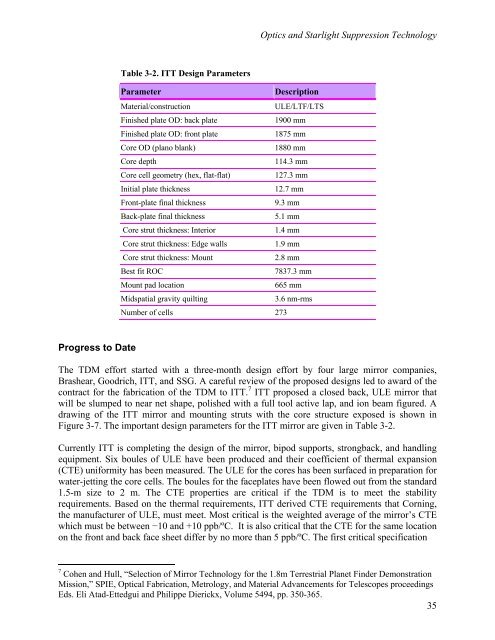TPF-C Technology Plan - Exoplanet Exploration Program - NASA
TPF-C Technology Plan - Exoplanet Exploration Program - NASA
TPF-C Technology Plan - Exoplanet Exploration Program - NASA
Create successful ePaper yourself
Turn your PDF publications into a flip-book with our unique Google optimized e-Paper software.
Optics and Starlight Suppression <strong>Technology</strong><br />
Table 3-2. ITT Design Parameters<br />
Parameter<br />
Description<br />
Material/construction<br />
ULE/LTF/LTS<br />
Finished plate OD: back plate<br />
1900 mm<br />
Finished plate OD: front plate<br />
1875 mm<br />
Core OD (plano blank)<br />
1880 mm<br />
Core depth<br />
114.3 mm<br />
Core cell geometry (hex, flat-flat)<br />
127.3 mm<br />
Initial plate thickness<br />
12.7 mm<br />
Front-plate final thickness<br />
9.3 mm<br />
Back-plate final thickness<br />
5.1 mm<br />
Core strut thickness: Interior<br />
1.4 mm<br />
Core strut thickness: Edge walls<br />
1.9 mm<br />
Core strut thickness: Mount<br />
2.8 mm<br />
Best fit ROC<br />
7837.3 mm<br />
Mount pad location<br />
665 mm<br />
Midspatial gravity quilting<br />
3.6 nm-rms<br />
Number of cells 273<br />
Progress to Date<br />
The TDM effort started with a three-month design effort by four large mirror companies,<br />
Brashear, Goodrich, ITT, and SSG. A careful review of the proposed designs led to award of the<br />
contract for the fabrication of the TDM to ITT. 7 ITT proposed a closed back, ULE mirror that<br />
will be slumped to near net shape, polished with a full tool active lap, and ion beam figured. A<br />
drawing of the ITT mirror and mounting struts with the core structure exposed is shown in<br />
Figure 3-7. The important design parameters for the ITT mirror are given in Table 3-2.<br />
Currently ITT is completing the design of the mirror, bipod supports, strongback, and handling<br />
equipment. Six boules of ULE have been produced and their coefficient of thermal expansion<br />
(CTE) uniformity has been measured. The ULE for the cores has been surfaced in preparation for<br />
water-jetting the core cells. The boules for the faceplates have been flowed out from the standard<br />
1.5-m size to 2 m. The CTE properties are critical if the TDM is to meet the stability<br />
requirements. Based on the thermal requirements, ITT derived CTE requirements that Corning,<br />
the manufacturer of ULE, must meet. Most critical is the weighted average of the mirror’s CTE<br />
which must be between −10 and +10 ppb/ºC. It is also critical that the CTE for the same location<br />
on the front and back face sheet differ by no more than 5 ppb/ºC. The first critical specification<br />
7 Cohen and Hull, “Selection of Mirror <strong>Technology</strong> for the 1.8m Terrestrial <strong>Plan</strong>et Finder Demonstration<br />
Mission,” SPIE, Optical Fabrication, Metrology, and Material Advancements for Telescopes proceedings<br />
Eds. Eli Atad-Ettedgui and Philippe Dierickx, Volume 5494, pp. 350-365.<br />
35
















